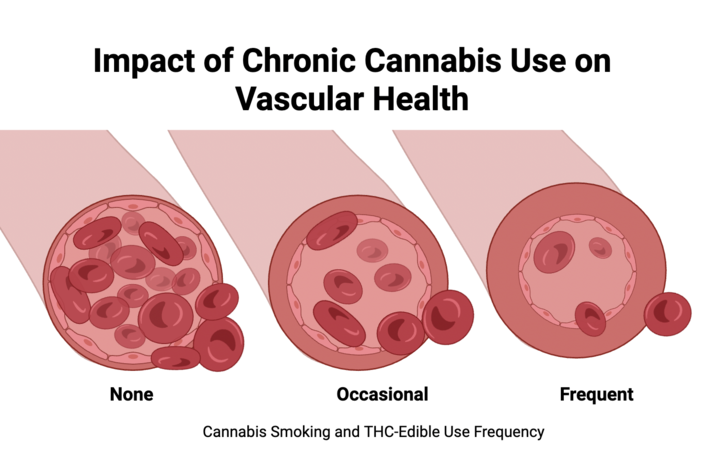Behind the High: How Chronic Cannabis Use Affects Your Vessels
An infographic titled “Impact of Chronic Cannabis Use on Vascular Health” shows three blood vessels side by side:
None (baseline/healthy): The leftmost vessel is wide with many healthy red blood cells flowing smoothly, representing normal endothelial function and vascular health.
Occasional: The middle vessel remains open with red blood cells flowing, showing no detectable long-term dysfunction from occasional cannabis use.
Frequent: The rightmost vessel is narrowed with fewer red blood cells passing through, illustrating endothelial dysfunction and impaired vascular health associated with chronic cannabis use.
The caption at the bottom notes: “Cannabis Smoking and THC-Edible Use Frequency.”
By Soham Ray & Lily Ortiz
What is the study about?
Weed, pot, the devil’s lettuce– whatever you may call it, cannabis use has significantly grown in the United States [1]. The legalization and decriminalization of cannabis in states across the country has resulted in increased use of cannabis products and the frequency at which we use them [2]. Although there is some debate about whether recreational cannabis laws are linked with increased cannabis use, nearly half of the U.S. population view cannabis to be “low risk”[3, 4].
However, cannabis’s effects on human health are not yet completely understood. This is why Mohammadi et al. from the University of California, San Francisco decided to investigate how chronic cannabis use impacts vascular endothelial cells (cells that line the vascular system) such as arteries, veins, and capillaries. This was inspired by Dr. Springer’s research on the health impacts of tobacco use.
A healthy endothelium is essential for regulating blood pressure, preventing blood clots, regulating an immune response, and overall healthy heart function.
How was it conducted?
In order to test for proper vascular function, the researchers measured several metrics:
Short-term vessel function: The researchers looked at the ability of participants’ blood vessels to widen when there was an increase in blood flow.
You’ve likely been tested for this during a routine check-up when a nurse takes your blood pressure. The cuff inflates tightly around your arm, and when it’s released, you can feel the blood rush back. That sudden return of blood flow is what researchers use in a test called flow-mediated dilation to see how well your blood vessels expand, an indicator of healthy vascular function.
Long-term vessel function: The scientists also used a blood pressure cuff and sensor system to record the shape and timing of pressure waves in the participants’ arteries. This allowed them to estimate the pressure in the large arteries near your heart, which can give a better picture of how much strain your heart and blood vessels are under.
Stiffer vessels = heart working harder = higher risk for heart disease
Nitric oxide (NO) production: Nitric oxide is a natural chemical that your blood vessels make which tells them to relax and open up. This helps blood flow smoothly and keeps your arteries healthy. It was important for the researchers to study cannabis’s effect on NO production since previous studies have shown that both cannabis and tobacco use have been linked to worse cardiovascular outcomes; therefore, researchers suspected chronic cannabis use might impair NO production and tested for it. [5, 6].
Optimal NO = Better vessel function (Leading to normal blood pressure and proper oxygen delivery)
Lower than baseline NO production = poor vascular function (Increased risk of high blood pressure, plaque buildup on the arteries, and impaired oxygen delivery)
💭 What comes to mind when the phrase “chronic use” is mentioned?
Is it once a day, once a week, once a year? Mohammadi et. al. defines chronic cannabis use to be >3 smoking sessions/edibles per week for ≥1 year. The researchers studied 55 chronic cannabis users in San Francisco from age 18 to 50.
What did they discover?
What they didn’t see was increased stiffness in the chronic cannabis-using participants, indicating that at least for the people they studied, chronic cannabis use did not negatively impact their long-term blood vessel function.
The results did show that chronic cannabis use had an impact on short-term vessel function. This was the case for both people who regularly smoked and for those that regularly consumed edibles. They even observed the following trend: The more times someone smoked cannabis or consumed THC edibles in a given week, the less their blood vessels would widen in response to increased blood flow. In other words, more chronic cannabis use resulted in impaired short-term blood vessel function.
Interestingly, the researchers also noted that NO production was lower in chronic smokers, similar to what the researcher reported in tobacco smokers, but not in those that were chronic THC-edible users.
Why does it matter?
The study revealed that, contrary to what was previously and is often still believed, chronic cannabis use– including edibles but especially smoking– can put you at-risk for poor cardiovascular health.
As is the case with any drug, it is important for users to understand its impacts, both positive and negative, when deciding to consume it. Caffeine, alcohol, and nicotine are widely used and culturally relevant drugs which has resulted in many studies showcasing the impacts that these substances have on human health. Cannabis, on the other hand, has only recently been legalized in 24 U.S. states and has therefore yet to be rigorously studied.
Overall, this research adds to our body of knowledge on the health impacts of cannabis use: The findings enable health professionals to monitor for early signs of vascular problems, prompt companies to add appropriate product warnings, and allow for users to make informed personal choices around cannabis use.
A link to the full publication can be found here: https://jamanetwork.com/journals/jamacardiology/fullarticle/2834540
